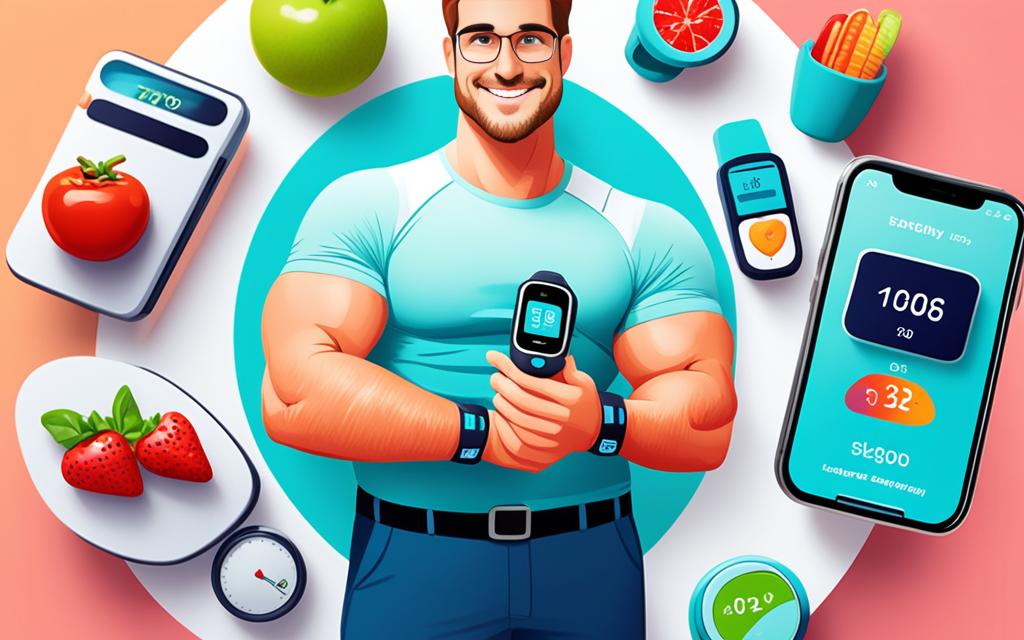Welcome to our comprehensive guide on continuous glucose monitoring (CGM) and its role in diabetes management. If you or a loved one are living with diabetes, you know how crucial it is to monitor blood sugar levels regularly. But did you know that CGM technology takes blood sugar monitoring to a whole new level?
A glucose monitoring system equipped with a CGM device and glucose sensor offers real-time insights into your blood glucose levels, providing you with accurate and up-to-date information for effective diabetes management. With CGM technology, you can make informed decisions about insulin dosing, ensuring that you stay on track and achieve better control over your blood sugar levels.
Key Takeaways:
- Continuous glucose monitoring (CGM) provides real-time insights into blood sugar levels.
- CGM technology enhances diabetes management by allowing for accurate insulin dosing.
- A glucose monitoring system consists of a CGM device and glucose sensor.
- Regular blood sugar monitoring is crucial for individuals with diabetes.
- CGM technology revolutionizes diabetes management, improving overall health outcomes.
Revolutionize Your Diabetes Management with Continuous Glucose Monitoring
Continuous Glucose Monitoring (CGM) has emerged as a game-changer in diabetes management, offering individuals with diabetes a revolutionary way to monitor their blood sugar levels. By utilizing advanced CGM technology, individuals can now have real-time insights into their glucose levels, paving the way for improved control and better health outcomes.
Unlike traditional blood glucose monitoring methods that require periodic finger pricks, CGM devices provide continuous and automatic monitoring throughout the day. This means no more painful finger pricks and the ability to track glucose levels conveniently and accurately.
The CGM device consists of a small sensor that is inserted just beneath the skin. This sensor continuously measures glucose levels in the interstitial fluid and transmits the data wirelessly to a receiver or smartphone app. This real-time data provides crucial information about blood sugar trends, helping individuals make informed decisions about insulin dosing and lifestyle adjustments.
CGM technology has transformed the way individuals manage their diabetes. The convenience, efficiency, and accuracy it offers are unparalleled, giving individuals the power to take control of their health like never before.
Continuous Glucose Monitoring has several advantages over traditional blood glucose monitoring methods. With CGM, individuals can proactively manage their diabetes by identifying patterns and trends in their glucose levels. This wealth of information allows for more timely and precise intervention, reducing the risk of hypo- or hyperglycemic episodes.
Moreover, CGM technology has proven to be particularly beneficial for people with fluctuating glucose levels or those who experience frequent hypoglycemia. The real-time glucose monitoring offered by CGM devices provides early warnings, helping individuals prevent dangerous drops in blood sugar levels.
Improved glucose control and reduced diabetes-related complications
- Continuous glucose monitoring helps individuals make more informed decisions about insulin dosing, leading to improved glucose control.
- Real-time data empowers individuals to identify and address blood sugar fluctuations promptly.
Enhanced lifestyle flexibility
- CGM technology allows for more flexibility in daily activities, including exercise, meal planning, and sleep.
- Individuals can make necessary adjustments to their lifestyle choices based on the real-time glucose data from their CGM device.
Peace of mind
- Continuous glucose monitoring minimizes the fear and stress associated with managing diabetes.
- It provides a constant stream of information, reducing the need for frequent finger pricks and guesswork.
By revolutionizing diabetes management, CGM technology has become an invaluable tool for individuals with diabetes. Its convenience, accuracy, and efficiency not only simplify blood sugar monitoring but also empower individuals to make proactive decisions to control their diabetes.
In the next section, we will explore how continuous glucose monitoring guarantees efficient and accurate blood sugar monitoring. We will delve into the features of CGM technology that ensure individuals have complete control over their diabetes management.
Efficient and Accurate Blood Sugar Monitoring with CGM Technology
In this section, we will explore the features and capabilities of continuous glucose monitoring (CGM) technology in ensuring efficient and accurate blood sugar monitoring. CGM systems provide real-time glucose monitoring, allowing individuals with diabetes to track their blood glucose levels throughout the day.
One of the key components of CGM technology is the glucose sensor. The glucose sensor is a small device that is inserted under the skin to measure glucose levels in the interstitial fluid. It continuously records glucose readings and sends the data to the CGM device. This real-time data provides individuals with valuable insights into their blood sugar levels, helping them make informed decisions about their diabetes management.
The glucose sensor plays a crucial role in providing reliable and continuous data for effective diabetes management. It eliminates the need for frequent fingerstick testing and enables individuals to monitor their glucose levels more conveniently. With continuous glucose monitoring, individuals can detect trends and patterns in their blood sugar levels, making it easier to adjust their insulin dosage and make necessary lifestyle changes.
“Continuous glucose monitoring revolutionizes blood sugar monitoring for individuals with diabetes by providing real-time data and eliminating the need for frequent fingerstick testing.”
With CGM technology, individuals can set customizable high and low glucose alerts. These alerts notify them when their blood sugar levels are outside the target range, allowing for timely intervention to prevent complications. Continuous glucose monitoring empowers individuals to take control of their diabetes management more effectively, leading to improved health outcomes.
Conclusion
In conclusion, continuous glucose monitoring (CGM) is a game-changer in diabetes management. With its ability to provide real-time glucose monitoring, CGM technology offers significant benefits for individuals with diabetes.
By incorporating a glucose monitoring system that utilizes a CGM device and glucose sensor, individuals can experience more accurate insulin dosing and better control of their blood sugar levels. This can lead to improved overall health outcomes and a higher quality of life.
We encourage readers to consider the advantages of continuous glucose monitoring and discuss this option with their healthcare provider. By staying on track with CGM technology, individuals can take control of their diabetes management and achieve better health outcomes.


